

Atomic Trampoline. Physicists observe 'negative mass' Image copyright SCIENCE PHOTO LIBRARY Physicists have created a fluid with "negative mass", which accelerates backwards when pushed.
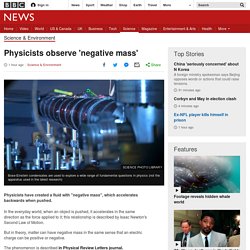
In the everyday world, when an object is pushed, it accelerates in the same direction as the force applied to it; this relationship is described by Isaac Newton's Second Law of Motion. But in theory, matter can have negative mass in the same sense that an electric charge can be positive or negative. The phenomenon is described in Physical Review Letters journal.
Prof Peter Engels, from Washington State University (WSU), and colleagues cooled rubidium atoms to just above the temperature of absolute zero (close to -273C), creating what's known as a Bose-Einstein condensate. In this state, particles move extremely slowly, and following behaviour predicted by quantum mechanics, acting like waves. They also synchronise and move together in what's known as a superfluid, which flows without losing energy. Exposing a sheet of thermochromic liquid crystals to a source of heat causes a local shift in its structure that produces a vivid change in color. Scientists have confirmed a brand new form of matter: time crystals. Blood-repellent materials: A new approach to medical implants. Medical implants like stents, catheters and tubing introduce risk for blood clotting and infection – a perpetual problem for many patients.

Colorado State University engineers offer a potential solution: A specially grown, “superhemophobic” titanium surface that’s extremely repellent to blood. The material could form the basis for surgical implants with lower risk of rejection by the body. Biomedical, materials approaches It’s an outside-the-box innovation achieved at the intersection of two disciplines: biomedical engineering and materials science.
The work, recently published in Advanced Healthcare Materials, is a collaboration between the labs of Arun Kota, assistant professor of mechanical engineering and biomedical engineering; and Ketul Popat, associate professor in the same departments. Paper bike helmet wins Dyson award. Image copyright Dyson A recyclable, folding cycling helmet made of paper has won this year's international James Dyson Award.
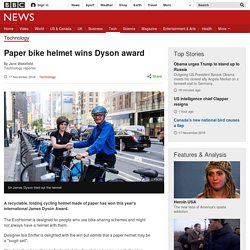
The EcoHelmet is designed for people who use bike-sharing schemes and might not always have a helmet with them. Designer Isis Shiffer is delighted with the win but admits that a paper helmet may be a "tough sell". She describes herself as an "ardent but slow" cyclist and came up with the idea when she was using bike-sharing schemes around the world. "When I was exploring new cities I had no access to a helmet and I didn't want to spend $30 buying one," she told the BBC. She decided to design one, made of cheap, recyclable materials that would cost less than $5. The helmet uses a honeycomb structure to protect the head which, according to Ms Shiffer, is "incredibly good at absorbing impact". The design was tested at Imperial College in London. Tesla shows off solar roof tiles. Image copyright Reuters Roof tiles with built-in solar panels have been unveiled by Tesla chief executive Elon Musk.
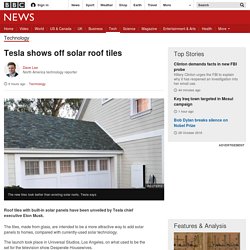
The tiles, made from glass, are intended to be a more attractive way to add solar panels to homes, compared with currently-used solar technology. The launch took place in Universal Studios, Los Angeles, on what used to be the set for the television show Desperate Housewives. It comes with Tesla due to take over struggling energy firm Solar City. Silkworms Spin Super-Silk After Eating Carbon Nanotubes and Graphene. Materials programmed to shape shift. Scientists have pre-programmed materials to change their shape over time.
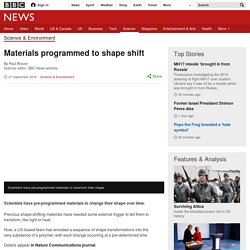
Previous shape-shifting materials have needed some external trigger to tell them to transform, like light or heat. Vantablack, 'world's blackest material,' now comes in a spray. Let's all try to imagine what the blackest possible black might look like.
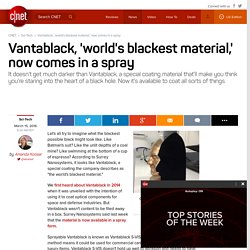
Origami Footwear: Lightweight Lace-Free Shoes Wrap & Fit Any Feet. A Japanese designer and Italian shoemaker have taken a fresh approach to athletic footwear, adapting the minimalist art of cloth wrapping to form the basis of a flexible shoe that fits any foot shape.

Masaya Hashimoto worked with Vibram, the makers of foot-shaped FiveFingers shoes (with articulated toes), to create the Furoshiki series of shoes with wrapping soles that fold around feet without needing laces (a simple hook and and loop system). A specially-engineered gripping system keeps the shoes in place and make it possible for the shoe to perform like ordinary footwear but with less weight and material. The system has a number of advantages, including more flexible sizing than traditional shoes, easier packing for travel and the ability to skip socks comfortably.
From Vibram: “The concept for this type of footwear was derived from the Japanese custom of packaging items by wrapping them in cloth fabric. Furoshiki is the only sole on the market that wraps around the entire foot. New Compound Can Transform Infrared into Visible Light. A team of scientists in Germany has developed a compound that can transform infrared into warm, white-colored light.
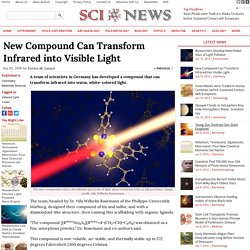
The new compound emits a broadband spectrum of light upon excitation with an infrared laser. Image credit: Nils Wilhelm Rosemann. The team, headed by Dr. Nils Wilhelm Rosemann of the Philipps-Universität Marburg, designed their compound of tin and sulfur, and with a diamondoid-like structure, then coating this scaffolding with organic ligands. “The compound [(RdelocSn)4S6](Rdeloc=4–(CH2=CH)–C6H4) was obtained as a fine amorphous powder,” Dr. This compound is non-volatile, air-stable, and thermally stable up to 572 degrees Fahrenheit (300 degrees Celsius). “Inorganic nanocrystals form the core of this compound and are coated with organic ligands on the surface,” they explained.
“The visible part of the spectrum resembles the color of a tungsten-halogen lamp at 2,900 Kelvin while retaining the superior beam divergence of the driving laser,” the researchers said. Flat lens promises possible revolution in optics. Image copyright Federico Capasso A flat lens made of paint whitener on a sliver of glass could revolutionise optics, according to its US inventors.

Just 2mm across and finer than a human hair, the tiny device can magnify nanoscale objects and gives a sharper focus than top-end microscope lenses. It is the latest example of the power of metamaterials, whose novel properties emerge from their structure. Milestone in solar cell efficiency by UNSW engineers. A new solar cell configuration developed by engineers at the University of New South Wales has pushed sunlight-to-electricity conversion efficiency to 34.5% – establishing a new world record for unfocused sunlight and nudging closer to the theoretical limits for such a device.

The record was set by Dr Mark Keevers and Professor Martin Green, Senior Research Fellow and Director, respectively, of UNSW’s Australian Centre for Advanced Photovoltaics, using a 28-cm2 four-junction mini-module – embedded in a prism – that extracts the maximum energy from sunlight.